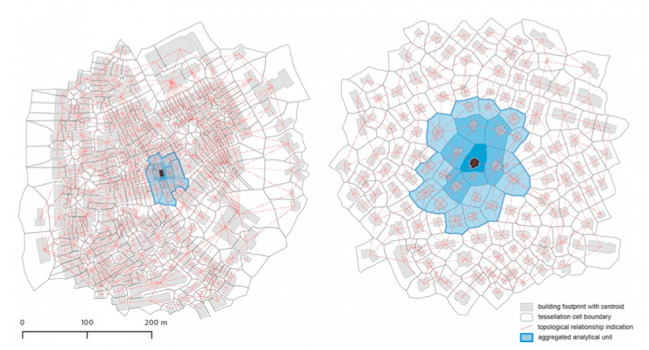 Fleischmann M, Feliciotti A, Romice O, Porta S (2020) Morphological tessellation as a way of partitioning space: Improving consistency in urban morphology at the plot scale. Computers, Environment and Urban Systems 80: 101441. DOI: 10.1016/j.compenvurbsys.2019.101441.
Fleischmann M, Feliciotti A, Romice O, Porta S (2020) Morphological tessellation as a way of partitioning space: Improving consistency in urban morphology at the plot scale. Computers, Environment and Urban Systems 80: 101441. DOI: 10.1016/j.compenvurbsys.2019.101441.Urban Morphometrics (UMM) is an expanding area of urban studies that aims at representing and measuring objectively the physical form of cities to support evidence-based research. An essential step in its development is the identification of a suitable spatial unit of analysis, where suitability is determined by its degree of reliability, universality, accessibility and significance in capturing essential urban form patterns. In Urban Morphology such unit is found in the plot, a fundamental component in the morphogenetic of urban settlements. However, the plot is a conceptually and analytically ambiguous concept and a kind of spatial information often unavailable or inconsistently represented across geographies, issues that limit its reliability and universality and hence its suitability for Urban Morphometric applications. This calls for alternative methods of deriving a spatial unit able to convey reliable plot-scale information, possibly comparable with that provided by plots.
This paper presents Morphological Tessellation (MT), an objectively and universally applicable method that derives a spatial unit named Morphological Cell (MC) from widely available data on building footprint only and tests its informational value as proxy data in capturing plot-scale spatial properties of urban form. Using the city of Zurich (CH) as case study we compare MT to the cadastral layer on a selection of morphometric characters capturing different geometrical and configurational properties of urban form, to test the degree of informational similarity between MT and cadastral plots.
Findings suggest that MT can be considered an efficient informational proxy for cadastral plots for many of the tested morphometric characters, that there are kinds of plot-scale information only plots can provide, as well as kinds only morphological tessellation can provide. Overall, there appears to be clear scope for application of MT as fundamental spatial unit of analysis in Urban Morphometrics, opening the way to large-scale urban morphometric analysis.


